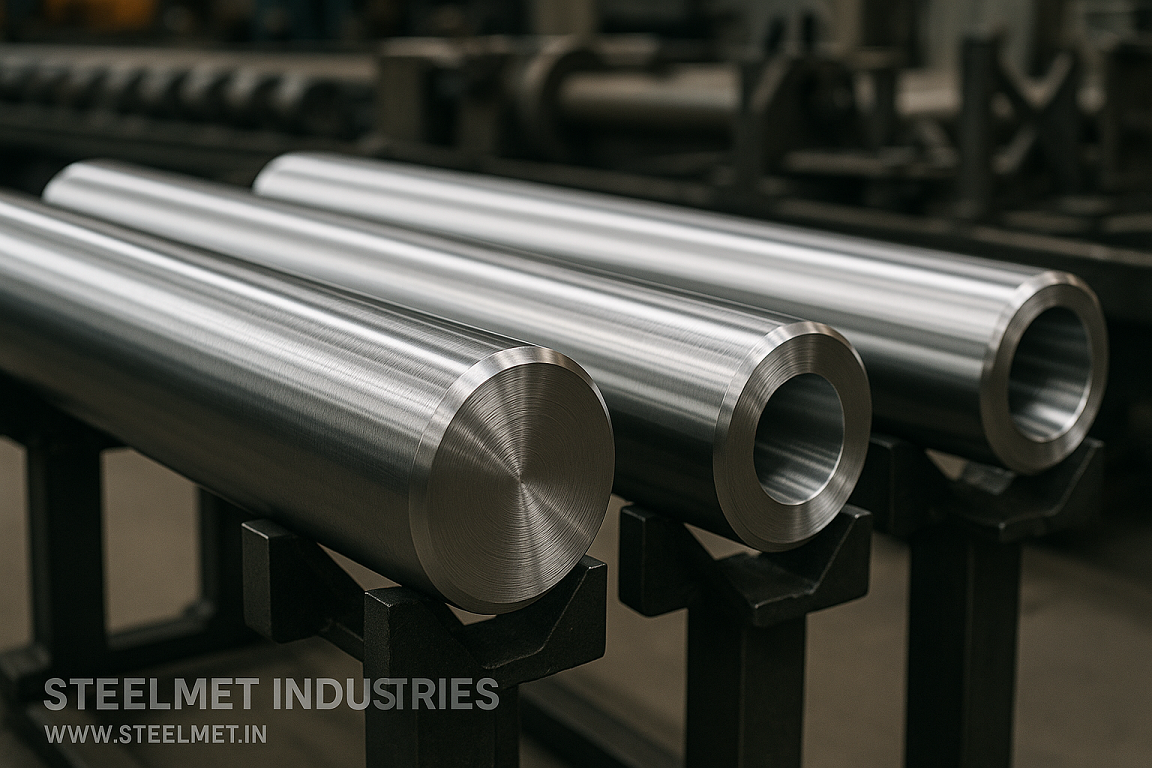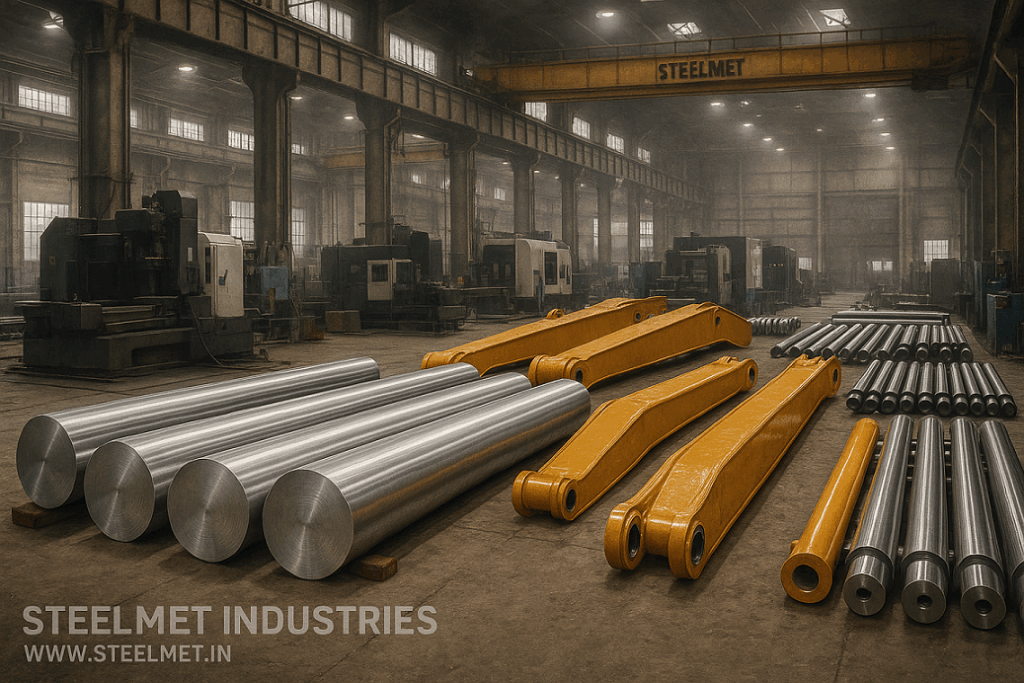Bright Steel Bars for Heavy Engineering & Earthmoving Components
Earthmoving and heavy engineering components operate under high loads, abrasive environments and continuous shock cycles. Bright steel bars provide the dimensional accuracy, controlled chemistry, straightness and predictable heat-treatment response required for pins, shafts, rollers and high-load bearing components used in excavators, loaders, cranes and mining equipment.

Heavy-duty bright bars prepared for machining into excavator pins, loader shafts and structural components.
Key Applications in Heavy Engineering & Earthmoving
- Excavator and loader pins
- Track rollers and idler shafts
- Boom, arm and bucket linkage pins
- Hydraulic cylinder rods and mounting pins
- Crane and hoist shafts
- Wear-prone bushings and sleeves
- Stabilizer rods and landing gear components
Component Groups & Applications
Excavator Pins & Linkage Pins
Excavator and loader pins require high surface hardness, wear resistance and core toughness to withstand constant shock, abrasive soil and rock contact. Bright bars reduce machining deviations and improve consistency before heat treatment and surface hardening.
Track Rollers & Idler Shafts
Rollers and idler shafts demand excellent wear resistance and concentricity to avoid premature track misalignment and failure. Dimensional stability during heat treatment is critical.
Hydraulic Cylinder Pins & Mountings
Mounting pins, pivot points and cylinder attachments must support high-pressure loads and repetitive cycling. Bright bars provide the mechanical stability required for critical joints.
Why bright bars are ideal for heavy-duty components
- Superior OD control reduces bush wear and extends service intervals.
- Predictable case-hardening and Q&T response improves component reliability.
- Reduced machining allowances lower production time and tool wear.
- Improved straightness and roundness reduce assembly issues and field failures.
- Available in high-strength, wear-resistant and alloy steels suited for extreme loads.
Real-world use case
An excavator manufacturer replacing hot-rolled bars with EN19 bright bars for 45–70 mm pins significantly reduced the final grinding requirement. When supplied Q&T with controlled straightness, pins achieved more consistent hardness profiles and improved wear life when paired with hardened bushings.
Quick decision pointers
- For loader and excavator pins: EN19 (4140) Q&T offers an excellent balance of wear resistance and impact toughness.
- For roller and idler shafts: EN24 (4340) provides superior fatigue and surface hardness for long-term heavy-duty service.
- For case-hardened bores and sliding contact surfaces: 20MnCr5 allows for deep, uniform case depth with strong core support.
- For extreme wear or bearing applications: EN31 (52100) offers high contact fatigue strength.
Failure-prevention and quality notes
- Specify bushing compatibility; mismatched hardness between pin and bush accelerates wear.
- Define surface hardness and case depth clearly for linkage pins to avoid premature flaking or pitting.
- Monitor straightness after heat treatment; distortion can exceed fit tolerance if not controlled.
- Check surface decarburisation limits prior to assembly — even minor decarb can drastically reduce fatigue performance.
Standards & Equivalents (Table 1)
| IS | BS970 | AISI/SAE | DIN/EN | JIS | GOST | GB |
|---|---|---|---|---|---|---|
| C45 | EN8 | 1045 | C45E / 1.1191 | S45C | 45 | 45# |
| EN19 | 708M40 | 4140 | 42CrMo4 / 1.7225 | SCM440 | 40Х | 42CrMo |
| EN24 | 817M40 | 4340 | 34CrNiMo6 / 1.6582 | SNCM447 | 40ХН2МА | 34CrNiMo6 |
| 20MnCr5 | 655M20 | — | 20MnCr5 / 1.7147 | SCM420H | 20ХГ | 20CrMn |
| EN31 | 070M55 | 52100 | 1.3505 | SUJ2 | ШХ15 | GCr15 |
Grade Selection, Performance & Heat Treatment (Table 2)
| Grade | Typical Application in Heavy Engineering | Performance Indicators | Typical Heat Treatment Route |
|---|---|---|---|
| C45 / EN8 (1045) | Used for moderate-load pins, stabilizer rods and pivot shafts where cost and ease of machining are important and loads are lower. | Machinability: Medium | Hardenability: Low/Medium | Wear Resistance: Moderate | Fatigue Strength: Moderate | Normalize or Q&T; induction hardening for local wear zones if required. |
| EN19 (4140 / 42CrMo4) | Common choice for excavator pins, heavy pivot shafts and high-load attachments due to excellent toughness and predictable heat-treatment response. | Machinability: Medium | Hardenability: Good | Wear Resistance: High | Fatigue Strength: High | Quench & Temper (Q&T); often combined with induction hardening at wear surfaces. |
| EN24 (4340 / 34CrNiMo6) | Used for rollers, idler shafts, crane shafts and high-impact components requiring excellent fatigue resistance, toughness and deep hardenability. | Machinability: Medium/Low | Hardenability: Excellent | Wear Resistance: Very High | Fatigue Strength: Very High | Quench & Temper; may include cryogenic treatment for enhanced fatigue properties. |
| 20MnCr5 (case-hardening) | Ideal for sliding interfaces and high-wear bores in heavy machinery, providing a hard case over a tough core that resists shock loads. | Machinability: Medium | Hardenability: Low (for case) | Wear Resistance: High (after case) | Fatigue Strength: High (core) | Carburize + Q&T; typical case depth 1.0–1.5 mm for heavy-duty pins. |
| EN31 / 52100 | Used for high-wear applications such as bushings, roller elements and pins subjected to consistent abrasive or rolling contact. | Machinability: Low | Hardenability: Excellent | Wear Resistance: Very High | Fatigue Strength: Very High | Through-hardened and tempered; used where high contact fatigue strength is needed. |
Inspection & manufacturing checklist
- Verify core hardness after heat treatment—heavy pins require controlled gradients to prevent brittleness.
- Ensure wear surfaces are induction hardened evenly to reduce localized pitting.
- Measure roundness and diameter before assembly; oversized pins accelerate bush wear.
- Specify NDT (UT or MPI) for high-load or critical lifting equipment components.
Frequently Asked Questions
Which grade is best for excavator pins?
EN19 (4140) Q&T is commonly used due to its balance of toughness and wear resistance. Higher wear areas may use EN24 (4340) or induction-hardened surfaces.
When should EN24 be preferred over EN19?
Choose EN24 (4340) when deeper hardenability, higher fatigue strength and better shock resistance are required — such as rollers, idlers and crane shafts.
Is case hardening suitable for heavy engineering parts?
Yes. 20MnCr5 is widely used for parts requiring wear-resistant surfaces and a strong core. Specify case depth and hardness profiles correctly.
Contact for Heavy Engineering Component Requirements
For excavator pins, rollers, idlers, boom pins or any high-strength parts requiring bright bar inputs:
Related: Complete guide to bright steel bar applications — Hydraulics & Pneumatics — Industrial Machinery Components

